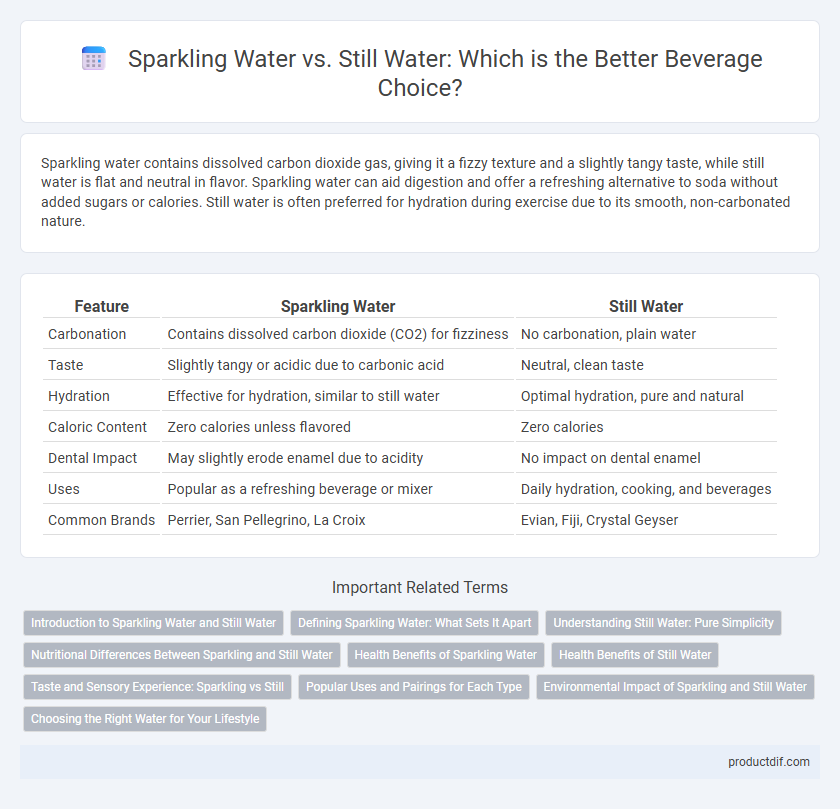Sparkling water contains dissolved carbon dioxide gas, giving it a fizzy texture and a slightly tangy taste, while still water is flat and neutral in flavor. Sparkling water can aid digestion and offer a refreshing alternative to soda without added sugars or calories. Still water is often preferred for hydration during exercise due to its smooth, non-carbonated nature.
Table of Comparison
| Feature | Sparkling Water | Still Water |
|---|---|---|
| Carbonation | Contains dissolved carbon dioxide (CO2) for fizziness | No carbonation, plain water |
| Taste | Slightly tangy or acidic due to carbonic acid | Neutral, clean taste |
| Hydration | Effective for hydration, similar to still water | Optimal hydration, pure and natural |
| Caloric Content | Zero calories unless flavored | Zero calories |
| Dental Impact | May slightly erode enamel due to acidity | No impact on dental enamel |
| Uses | Popular as a refreshing beverage or mixer | Daily hydration, cooking, and beverages |
| Common Brands | Perrier, San Pellegrino, La Croix | Evian, Fiji, Crystal Geyser |
Introduction to Sparkling Water and Still Water
Sparkling water contains dissolved carbon dioxide gas, creating effervescence that enhances flavor and refreshment. Still water, free from carbonation, offers a pure, neutral taste ideal for hydration and mixing with other beverages. Both types provide essential hydration but cater to different preferences and uses in daily consumption.
Defining Sparkling Water: What Sets It Apart
Sparkling water is differentiated by its carbonation, which is the infusion of carbon dioxide gas creating effervescence and a distinct fizzy texture. Unlike still water, which is free from dissolved gases and maintains a flat, neutral profile, sparkling water often contains natural or artificial mineral additions that enhance flavor complexity. This carbonation not only alters the sensory experience but can also impact digestion and hydration differently compared to still water.
Understanding Still Water: Pure Simplicity
Still water offers pure hydration without carbonation, making it ideal for those seeking simplicity and natural refreshment. It contains no added sugars or flavors, providing essential minerals that support bodily functions and overall health. Preferred for its clean taste, still water remains a cornerstone in balanced hydration routines worldwide.
Nutritional Differences Between Sparkling and Still Water
Sparkling water contains dissolved carbon dioxide, which can result in a slightly lower pH and may cause mild acidity compared to still water, but both provide zero calories, sugars, and fats, making them hydrating options. Some sparkling waters include added minerals like calcium, magnesium, or sodium, contributing trace nutrients absent in pure still water. Still water generally supports neutral pH balance in the body, whereas sparkling water's carbonation can influence digestion by promoting burping or enhancing gastric motility.
Health Benefits of Sparkling Water
Sparkling water offers hydration benefits similar to still water while providing a fizzy alternative that can enhance digestion and reduce constipation. It contains carbon dioxide, which may promote feelings of fullness and support weight management without added sugars or calories. Unlike sugary soft drinks, sparkling water helps maintain oral health when consumed in moderation, making it a healthier choice for hydration.
Health Benefits of Still Water
Still water promotes optimal hydration by facilitating faster absorption and better retention in the body compared to sparkling water, which contains carbonation that may cause bloating or discomfort. It supports kidney function by aiding in toxin elimination without the acidic effect of carbonated drinks, thus reducing the risk of kidney stones and urinary tract infections. Additionally, still water is free from added sugars and artificial ingredients, making it an ideal choice for maintaining healthy skin and overall metabolic balance.
Taste and Sensory Experience: Sparkling vs Still
Sparkling water delivers a crisp, effervescent sensation with a slightly tangy flavor due to dissolved carbon dioxide, enhancing the overall sensory experience. Still water offers a smooth, neutral taste that accentuates natural mineral content, providing a clean and refreshing palate. Preference between sparkling and still water often depends on individual taste sensitivity to carbonation and desired mouthfeel.
Popular Uses and Pairings for Each Type
Sparkling water enhances the taste of cocktails, seafood, and light salads due to its effervescence, making it a popular choice in bars and social gatherings. Still water is favored for daily hydration, accompanying rich meals like steak or pasta, and serving as a neutral palate cleanser in fine dining. Both types cater to different taste preferences and meal pairings, with sparkling water often used to add a refreshing bite and still water providing a subtle complement.
Environmental Impact of Sparkling and Still Water
Sparkling water has a higher environmental impact than still water primarily due to the carbonation process, which requires additional energy and emits more greenhouse gases. The production, packaging, and transportation of sparkling water often involve more plastic and glass bottles, increasing waste and carbon emissions. In contrast, still water's simpler production chain results in lower overall environmental footprints, making it a more sustainable choice for consumers concerned about ecological impact.
Choosing the Right Water for Your Lifestyle
Sparkling water offers a refreshing alternative with its carbonation, making it ideal for those seeking a flavorful, effervescent drink without added sugars or calories. Still water provides essential hydration without any taste or bubbles, suitable for individuals focusing on pure, straightforward hydration throughout the day. Choosing between sparkling and still water depends on personal preference, dietary needs, and lifestyle habits, including activity level and flavor preferences.
Sparkling Water vs Still Water Infographic

 productdif.com
productdif.com